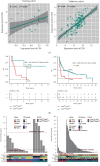Low Expression of CD5 and CD6 Is Associated with Poor Overall Survival for Patients with T-Cell Malignancies
- PMID: 35983088
- PMCID: PMC9381250
- DOI: 10.1155/2022/2787426
Low Expression of CD5 and CD6 Is Associated with Poor Overall Survival for Patients with T-Cell Malignancies
Abstract
Background: T-cell malignancies (TCMs), including T-cell acute lymphoblastic leukemia (T-ALL) and T-cell lymphoma (TCL), are highly aggressive and have a poor prognosis. To further understand prognostic stratifications and to design targeted therapies, this study aims to explore novel, potential biomarkers based on alterations in immune costimulatory molecules (CMs) for TCMs.
Methods: Peripheral blood from 25 de novo T-ALL patients in our clinical center and transcriptome data from 131 to 162 patients with peripheral TCL (PTCL) from the GSE19069 and GSE58445 dataset, respectively, were obtained to assess the expression levels of CMs and their prognostic significance.
Results: Seven CMs were associated with overall survival (OS). Among these CMs, CD5 and CD6 had the highest pairwise positive correlation (R = 0.69). CD5 and CD6 were significantly down-regulated in TCM patients compared with healthy individuals (HIs), and lower CD5 and CD6 expression was associated with poor OS for both T-ALL and TCL patients, particularly for patients greater than 60 years old. Furthermore, CD5 was positively correlated with CD6 in TCM patients. Compared with patients who were CD5highCD6high, T-ALL and TCL patients who were CD5lowCD6low had poor OS. Importantly, CD5highCD6high was an independent prognostic predictor for OS in T-ALL (HR = 0.39, 95% CI: 0.23-0.65, P < 0.001) and TCL (HR = 0.35, 95% CI: 0.19-0.62, P < 0.001) patients.
Conclusions: Low expression of CD5 and CD6 was associated with poor OS for TCM patients, and this may be a potential immune biomarker panel for prognostic stratification of TCM patients.
Copyright © 2022 Songnan Sui et al.
Conflict of interest statement
The authors declare that there are no conflicts of interest.
Figures




References
LinkOut - more resources
Full Text Sources
Miscellaneous

